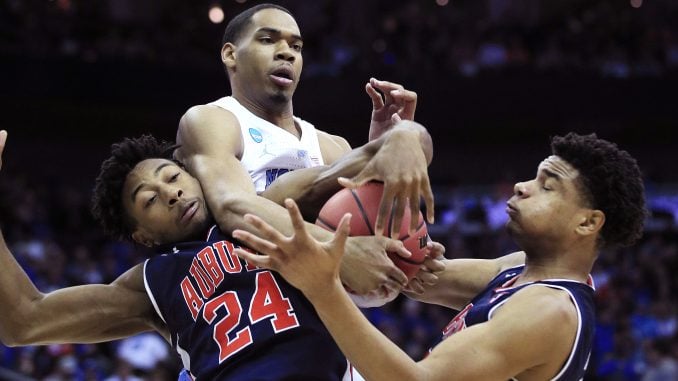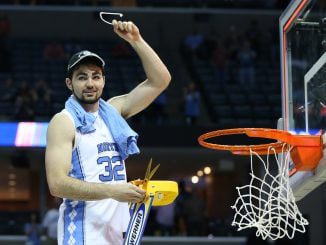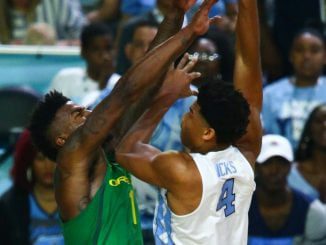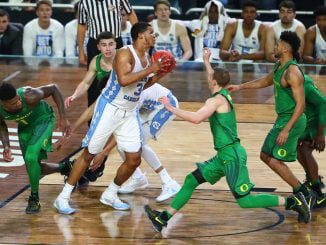
KANSAS CITY, Mo. — North Carolina’s 2018-19 basketball season came to an abrupt end at Sprint Center last Friday with a 97-80 loss to fifth-seeded Auburn.
It was an unexpected outcome for a top-seeded Tar Heels team that came into the game playing some of its best ball of the season. But with the luxury of hindsight, the result might not have been surprising as it first seemed.
Here is a look back at what went wrong for UNC on its shorter-than-expected trip to Kansas City.
Sick and tired
The first indication that the Sweet 16 matchup with Auburn was about to go sour came 24 hours before tipoff when freshman Nassir Little came down with the flu. He missed practice on Thursday and was moved to a separate room at the team hotel in an attempt to prevent anyone else from getting sick.
The plan didn’t work. First-team ACC forward Cameron Johnson also caught the bug and woke up on Friday with a temperature of 100. Both players gave it a go in their team’s most important game of the year. It was obvious, though, that neither was close to full strength.
Johnson, the team’s leading scorer, didn’t get his first basket until 3:21 was left in the first half. He gutted out 29 minutes and scored 15 points before spending the immediate aftermath of the game throwing up.
Little, meanwhile, was a shadow of the explosive offensive force he was during the Tar Heels’ first two NCAA games in Columbus, Ohio. He was 2 of 7 from the floor and had four of his shots blocked, including two dunk attempts. It’s not known if anyone else was under the weather, but UNC looked like a team running on fumes during a second half in which Auburn outscored it by 15 points.
The rule of three
The Tigers’ strength is the wealth of 3-point shooters on their roster. They showed it by knocking down 9 of 17 attempts in the first half of their second-round NCAA rout of Kansas and by connecting on 13 or more treys in four of their last five games.
As hot as Auburn’s shooters can be, they’re also known to be streaky — shooting less than 30 percent from beyond the arc seven times this season, including a loss at NC State in December.
Although it looked as though the bad Tigers might have shown up in Kansas City when they missed 14 of their 19 3-pointers in the first half, the hot Tigers arrived for the final 20 minutes by making 12 of their last 18 — including four off the bench by Danjel Purifoy after star Chuma Okeke (3 for 5) was injured.
A majority of Auburn’s second-half 3-pointers came on wide open looks, created by UNC’s defense continually getting sucked into the lane to stop the penetration of point guard Jared Harper.
“We thought there were some things we could do offensively to get our guys open,” Tigers coach Bruce Pearl said. “When you get a great point guard … they’re a load to stay in front of. And if we’ve got a guy on the perimeter that we can get open, (he’s) going to find them.”
Beaten on the boards
It was a generally accepted by both coaches going into the game that Auburn would have to shoot a high percentage to win, since the Tar Heels were a superior rebounding team and would control the glass the way they did against Iona and Washington in the first two rounds.
There was statistical evidence to back up that presumption, with UNC leading the nation in rebounding average at plus-10.5 per game and the Tigers ranking 229th at minus-1.1.
While the Tar Heels did actually win the numerical battle of the boards 40-36, Auburn was able to hold its own. And with 10 offensive rebounds, leading to 10 second-chance points, they were able to withstand a poor shooting first half and win the game going away.
“They didn’t do anything crazy. They just got to the right spots and got the ball,” sophomore center Garrison Brooks said. “It was tough to see, tough to deal with. That’s just how it went.”
Crouching Tiger, hidden power
Auburn might have been dismissed as just a football school at one point, especially after barely escaping a first-round upset at the hands of New Mexico State. But as it turns out, the Tigers were probably overlooked and underseeded as a No. 5.
They, not the Tar Heels, were the hottest team in the NCAA field. They knocked the blue out of three straight blue bloods — eliminating Kansas, UNC and Kentucky — on the road to Minneapolis, proving that their first ever Final Four trip is anything but a fluke.



